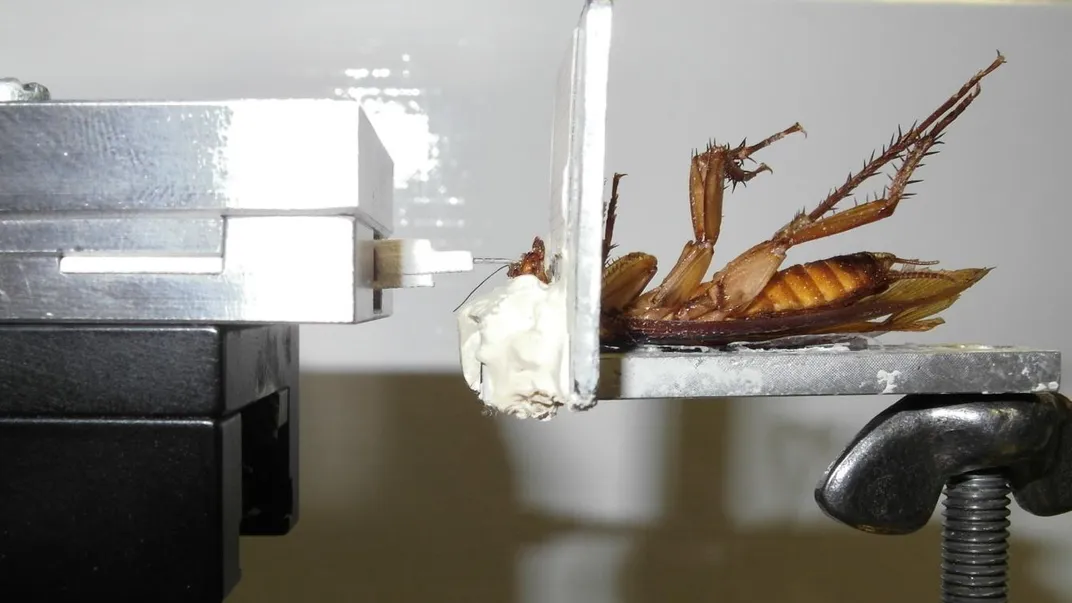A Cockroach Can Bite With a Force 50 Times Its Body Weight
Adding to their supervillain-esque powers, roaches can gnaw through tough materials with surprisingly strong jaws
/https://tf-cmsv2-smithsonianmag-media.s3.amazonaws.com/filer/92/e5/92e5f0e8-a6bb-483e-8951-d065a700228d/42-33326505.jpg)
Cockroaches can run across ceilings, squeeze through cracks as thin as a dime and live for up to two weeks after being beheaded.
As if these pests didn’t already have enough supervillain powers, lab tests have revealed another fascinating yet repulsive fact: Cockroaches can bite with a force 50 times greater than their body weight.
Scientists from the U.K. and Germany delved into this katsaridaphobic nightmare to fill in some important gaps in our understanding of animal physiology. Insects are all around us and play pivotal roles in ecosystems, the researchers write in their paper, appearing this week in PLOS ONE. Yet we know relatively little about certain basic biological workings, such as how their jaws function.
The team turned to the American cockroach as a starting point for figuring out insect mouth morphology, since roaches eat practically anything and have relatively primitive mandibles.
Ten American cockroaches raised in a lab colony took part in the study. To measure the insects' bite force, the researchers put the cockroaches into what looks like a miniature medieval torture device. Cockroaches were strapped upside down to a metal podium with their heads thrust under a guillotine-like plate. Dental cement further held their tiny faces in place.
Despite the setup, the cockroaches were not so uncomfortable that they refused to bite down on the sensor tip of a device for measuring mandible strength. Two of the roaches clamped down so hard on the sensor that they actually chipped their distal teeth, resulting in their data being disqualified from the study.
From the eight remaining insects, the researchers were able to collect data on 300 different bites. They also filmed each of the bites to determine mandible kinematics. The team then used the combined data to calculate the amount of stress each bite exerted on the roaches’ jaw muscles.
The roach bites were surprisingly strong—relating bite force to body weight, a roach bite is about five times more powerful than a human chomp, on average.

Not all bites were equally forceful, however. The team found that roaches roughly divided their efforts into short, weak bites produced by fast-moving muscle fibers and long, strong bites that required muscles to “power up” before reaching their maximum force. The latter version is likely reserved for working through tough material such as wood and leather, the team writes.
The team has yet to figure out how a roach’s relatively delicate head can withstand such repeated force over its lifetime. Working out these and other questions could yield more than basic biological facts. For instance, determining how roaches and other insects incorporate both slow crushing and fast cutting abilities into a single device—the mandibles—could eventually lead to innovations in robotics.
“With increasing miniaturization, such designs will become increasingly important,” Tom Weihmann, a zoologist at the University of Cambridge and lead author of the study, said in a statement. “Recent technical implementations in this direction are for instance micro-probes inserted into blood vessels or micro-surgical instruments.”
/https://tf-cmsv2-smithsonianmag-media.s3.amazonaws.com/accounts/headshot/Rachel-Nuwer-240.jpg)
/https://tf-cmsv2-smithsonianmag-media.s3.amazonaws.com/accounts/headshot/Rachel-Nuwer-240.jpg)